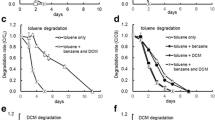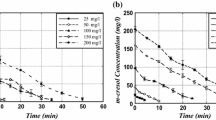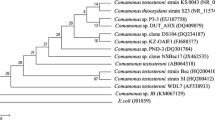Abstract
The inhibitory effect of creosote compounds on the aerobic degradation of benzene was studied in microcosm experiments. A total removal of benzene was observed after twelve days of incubation in microcosms where no inhibition was observed. Thiophene and benzothiophene, two heterocyclic aromatic compounds containing sulfur (S-compounds), had a significant inhibitory effect on the degradation of benzene, but also an inhibitory effect of benzofuran (an O-compound) and 1-methylpyrrole (a N-compound) could be observed, although the effect was weaker. The NSO-compounds also had an inhibitory effect on the degradation of p-xylene, o-xylene, and naphthalene, while they only had a weak influence on the degradation of 1-methylnaphthalene, o-cresol and 2,4-dimethylphenol. The phenolic compounds seemed to have a weak stimulating effect on the degradation of benzene whereas the monoaromatic hydrocarbons and the naphthalenes had no significant influence on the benzene degradation. The inhibitory effect of the NSO-compounds on the aerobic degradation of benzene could be identified as three different phenomena. The lag phase increased, the degradation rate decreased, and a residual concentration of benzene was observed in microcosms when NSO-compounds were present. The results show that NSO-compounds can have a potential inhibitory effect on the degradation of many creosote compounds, and that inhibitory effects in mixtures can be important for the degradation of different compounds.
Similar content being viewed by others
Abbreviations
- ben:
-
benzene
- bf:
-
benzofuran
- bt:
-
benzothiophene
- dmp:
-
2,4-dimethylphenol
- GC:
-
gas chromatograph
- ind:
-
indole
- mnap:
-
1-methylnaphthalene
- MAHs:
-
monoaromatic hydrocarbons
- mp:
-
1-methylpyrrole
- nap:
-
naphthalene
- NSO-compounds:
-
heterocyclic aromatic compounds containing nitrogen, sulphur or oxygen
- o-cre:
-
o-cresol
- o-xyl:
-
o-xylene
- PAHs:
-
polyaromatic hydrocarbons
- phe:
-
phenol
- p-xyl:
-
p-xylene
- pyr:
-
pyrrole
- thi:
-
thiophene
- qui:
-
quinoline
References
Alvarez PJJ & Vogel TM (1991) Substrate interactions of benzene, toluene and para-xylene during microbial degradation by pure cultures and mixed culture aquifer slurries. Appl. Environ. Microbiol. 57: 2981–2985
Alvarez PJJ, Anid PJ & Vogel TM (1991) Kinetics of aerobic biodegradation of benzene and toluene in sandy aquifer material. Biodegradation 2: 43–51
Arvin E, Jensen B, Aamand J & Jørgensen C (1988) The potential of free-living ground water bacteria to degrade aromatic hydrocarbons and heterocyclic compounds. Wat. Sci. Tech. 20: 109–118
Arvin E, Jensen BK & Gundersen AT (1989) Substrate interactions during aerobic biodegradation of benzene. Appl. Environ. Microbiol. 55: 3221–3225
Barbieri P, Palladino L, Gennaro PD & Galli E (1993) Alternative pathways for o-xylene or m-xylene and p-xylene in a Pseudomonas stutzeri strain. Biodegradation 4: 71–80
Bohonos N, Chou T-W & Spanggord RJ (1977) Some observations on biodegradation of pollutants in aquatic systems. Jpn. J. Antibiot. 30 (suppl.): 275–285
Chang M-K, Voice TC & Criddle CS (1993) Kinetics of competitive inhibition and cometabolism in the biodegradation of benzene, toluene, and p-xylene by two Pseudomonas isolates. Biotech. Bioeng. 41: 1057–1065
Constanti M, Bordons A & Giralt J (1994) Degradation of dibenzothiophene by Pseudomonas putida. Lett. Appl. Microbiol. 18: 107–111
Corseuil HX & Weber WJ (1994) Potential biomass limitations on rates of degradation of monoaromatic hydrocarbons by indigenous microbes in subsurface soils. Water Res. 28: 1415–1423
Duetz WA, Jong C, Williams PA & Andel JG (1994) Competition in chemostat culture between Pseudomonas strains that use different pathways for the degradation of toluene. Appl. Environ. Microbiol. 60: 2858–2863
Dyreborg S, Arvin E & Broholm K (1996) The influence of creosote compounds on the aerobic degradation of toluene. Biodegradation 7: 97–107
Eaton RW & Nitterauer JD (1994) Biotransformation of benzothiophene by isopropylbenzene-degrading bacteria. J. Bacteriol. 176: 3992–4002
Ehrlich GG, Goerlitz DF, Godsy EM & Hult MF (1982) Degradation of phenolic contaminants in ground water by anaerobic bacteria: St. Louis Park, Minnesota. Ground Water 20: 703–710
Fedorak PM (1990) Microbial metabolism of organosulfur compounds in petroleum. Geochemistry of Sulfur in Fossil Fuels. ACS Symposium Series 429: 93–112
Fedorak PM & Grbić-Galić D (1991) Aerobic microbial cometabolism of benzothiophene and 3-methylbenzothiophene. Appl. Environ. Microbiol. 57: 932–940
Flyvbjerg J, Arvin E, Jensen BK & Olsen SK (1993) Microbial degradation of phenols and aromatic hydrocarbons in creosotecontaminated groundwater under nitrate-reducing conditions. J. Contam. Hydrol. 12: 133–150
Fredrickson JK, Brockman FJ, Workman DJ, Li SW & Stevens TO (1991) Isolation and characterization of a subsurface bacterium capable of growth on toluene, naphthalene, and other aromatic compounds. Appl. Environ. Microbiol. 57: 796–803
Gibson DT & Subramanian (1984) Microbial degradation of aromatic hydrocarbons. In: Gibson DT (Ed) Microbial Degradation of Organic Compounds (pp 181–252). Marcel Dekker, Inc. New York
Gibson DT, Zylstra GJ & Chauhan S (1990) Biotransformations catalyzed by toluene dioxygenase from Pseudomonas putida F1. In: Silver S, Chakrabarty AM, Iglewski B & Kaplan S (Eds) Pseudomonas. Biotransformations, Pathogenesis, and Evolving Biotechnology (pp 121–132). American Society for Microbiology, Washington DC
Godsy EM, Goerlitz DF & Grbić-Galić D (1992) Methanogenic biodegradation of creosote contaminants in natural and simulated ground-water ecosystems. Ground Water 30: 322–242
Goerliz DF, Troutman DE, Godsy EM & Franks BJ (1985) Migration of wood-preserving chemicals in contaminated groundwater in a sand aquifer at Pensacola, Florida. Environ. Sci. Tech. 19: 955–961
Hinteregger C, Leitner R, Loidl M, Ferschl A & Streichsbier F (1992) Degradation of phenol and phenolic compounds by Pseudomonas putida EKII. Appl. Microbiol. Biotechnol. 37: 252–259
Jensen BK, Arvin E & Gundersen AT (1988) Biodegradation of nitrogen- and oxygen-containing aromatic compounds in ground-water from an oil-contaminated aquifer. J. Contam. Hydrol. 3: 65–75
Karlson U & Frankenberger WT (1989) Microbial degradation of benzene and toluene in groundwater. Bull. Environ. Contam. Toxicol. 43: 505–510
Korsgaard T, Petersen CR, Nielsen C, Andersen L, Michaelsen O, Skaarup J, Borg D, Andersen J, Bjerre B & Henriksen P (1989) Contaminated gasworks sites. Report No. U4. Danish Environmental Protection Agency, Copenhagen (in Danish)
Kukor JJ & Olsen RH (1990) Molecular cloning, characterization and regulation of Pseudomonas pickettii PK01 gene encoding phenol hydroxylase and expression of the gene Pseudomonas aeruginosa PA01c. J. Bacteriol. 172: 4624–4630
Lee J-Y, Roh J-R & Kim H-S (1994) Metabolic engineering of Pseudomonas putida for the simultaneous biodegradation of benzene, toluene, and p-xylene mixture. Biotech. Bioeng. 43: 1146–1152
Lee J-Y, Jung K-H & Kim H-S (1995) Amplification of toluene dioxygenase genes in a hybrid Pseudomonas strain to enhance the biodegradation of benzene, toluene, and p-xylene mixture. Biotech. Bioeng. 45: 488–494
Lotimer AR, Belanger DW & Whiffin RB (1992) Occurrences of coal tar and contaminated groundwater at three sites in Ontario. In: Weyer (Ed) Subsurface Contamination by Immiscible Fluids (pp 411–416). Int. Conf. on Subsurface Contamination by Immiscible Fluids, The International Association of Hydrogeologists, 18–20 April 1990, Calgary, Alberta, Canada. Balkema Rotterdam
Mahajan MC, Phale PS & Vaidyanathan CS (1994) Evidence for the involvement of multiple pathways in the biodegradation of 1- and 2-methylnaphthalene by Pseudomonas putida CSV86. Arch. Microbiol. 161: 425–433
Miethling R, Hecht V & Deckwer WD (1993) Microbial degradation of quinoline: kinetics studies with Comamonas acidovorans DSM 6426. Biotech. Bioeng. 42: 589–595
Millette D, Barker JF, Comeau Y, Butler BJ, Frind EO, Clément B & Samson R (1995) Substrate interaction during aerobic biodegradation of creosote-related compounds: a factorial batch experiment. Environ. Sci. Tech. 29: 1944–1952
Monna L, Omori T & Kodama T (1993) Microbial degradation of dibenzofuran, fluorene, and dibenzo-p-dioxin by Staphylococcus auriculans DBF63. Appl. Environ. Microbiol. 59: 285–289
Mueller JG, Chapman PJ & Pritchard PH (1989a) Creosotecontaminated sites. Their potential for bioremediation. Environ. Sci. Tech. 23: 1197–1201
Mueller JG, Chapman PJ & Pritchard PH (1989b) Action of a fluoranthene-utilizing bacterial community on polycyclic aromatic hydrocarbon components of creosote. Appl. Environ. Microbiol. 55: 3085–3090
Mueller JG, Middaugh DP, Lantz SE & Chapman PJ (1991) Biodegradation of creosote and pentachlorophenol in contaminated groundwater: Chemical and biological assessment. Appl. Environ. Microbiol. 57: 1277–1285
Pereira WE, Rostad CE, Garbarino JR & Hult MF (1983) Groundwater contamination by organic bases derived from coal-tar wastes. Environ. Tox. Chem. 2: 283–294
Pereira WE & Rostad CE (1986) Investigations of organic contaminants derived from wood-treatment processes in a sand and gravel Papers in the Hydrologic Science (pp 65–80). U.S. Geological S., Water Supply Paper No. 2290
Powlowski J & Shingler V (1994) Genetics and biochemistry of phenol degradation by Pseudomonas sp. CF600. Biodegradation 5: 219–236
Pyka W (1993) Aqueous solubility of coal-tar constituents under equilibrium conditions. In: Arendt F, Annokkee GJ, Bosman R & Brink WJ (Eds) Contaminated Soils '93 (pp 549–555), 4. International KfK/TNO Conference on Contaminated Soil, 3–7 May 1993, Berlin, Germany. Kluwer Academic Publ. Dordrecht, The Netherlands
Raven KG & Beck P (1992) Coal tar and creosote contamination in Ontario. In: Weyer (Ed) Subsurface Contamination by Immiscible Fluids (pp 401–410). Int. Conf. on Subsurface Contamination by Immiscible Fluids, The International Association of Hydrogeologist, 18–20 April 1990, Calgary, Alberta, Canada. Balkema. Rotterdam
SAS (1985) version 6, release 6.02 SAS Institute Inc. Cary, N.C. USA
Shields MS, Montgomery SO, Cuskey SM, Chapman PJ & Pritchard PH (1991) Mutants of Pseudomonas cepacia G4 defective in catabolism of aromatic compounds and trichloroethylene. Appl. Environ. Microbiol. 57: 1935–1941
Shukla OP (1987) Microbiological transformation and biodegradation of quinoline: isolation and characterization of quinolinedegrading bacteria and identification of early intermediates. Biol. Mem. 13: 115–131
Stringfellow WT & Aitken MD (1995) Competitive metabolism of naphthalene, methylnaphthalenes, and fluorene by phenanthrene-degrading pseudomonads. Appl. Environ. Microbiol. 61: 357–362
Stuermer DH, Ng DJ & Morris CJ (1982) Organic contaminants in groundwater near an underground coal gasification site in North-eastern Wyoming. Environ. Sci. Tech. 16:582–587
Sundström G, Larsson É & Tarkpea M (1986) Creosote. In: Hutzinger O (Ed) Handbook of Environmental Chemistry, Anthropogenic Compounds, 3 (pp 159–205). Springer-Verlag, Berlin
Thomas AO & Lester JN (1993) Degradation of phenols using bacteria isolated from the subsurface of manufactured gas plants. Hazard. Waste Hazard. Mater. 10: 413–430
Turney GL & Goerlitz DF (1990) Organic contamination of ground water at gas works park, Seattle, Washington. GWMR 10: 187–198
Verschueren K (1983) Handbook of Environmental Dara on Organic Chemicals, 2nd edn. Van Nostrand Reinhold, New York
Volkering F, Breure AM & Andel JG (1993) Effect of microorganisms on the bioavailability and biodegradation of crystalline naphthalene. Appl. Microbiol. Biotech. 40: 535–540
Whited GM & Gibson DT (1991) Separation and partial characterization of the enzymes of the toluene-4-monooygenase catabolic pathway in Pseudomonas mendocina KR1. J. Bacteriol. 173: 3017–3020
Williams PA & Sayers JR (1994) The evolution of pathways for aromatic hydrocarbon oxidation in Pseudomonas. Biodegradation 5: 195–217
Worsey MJ & Williams PA (1975) Metabolism of toluene and xylenes by Pseudomonas putida (arvilla) mt-2: evidence for a new function of the TOL plasmid. J. Bacteriol. 124: 7–13
Zylstra GJ & Gibson DT (1989) Toluene degradation by Pseudomonas putida F1: nucleotide sequence of the todC1C2BADE genes and theier expression in Escherichia coli. J. Biol. Chem. 264: 14940–14946
Author information
Authors and Affiliations
Rights and permissions
About this article
Cite this article
Dyreborg, S., Arvin, E. & Broholm, K. Effects of creosote compounds on the aerobic bio-degradation of benzene. Biodegradation 7, 191–201 (1996). https://doi.org/10.1007/BF00058179
Accepted:
Issue Date:
DOI: https://doi.org/10.1007/BF00058179




